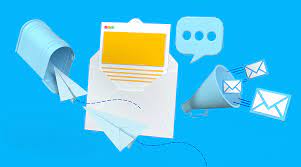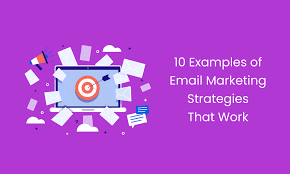E-Marketing Campaign: A Key to Online Success
In today’s digital age, having a strong online presence is crucial for the success of any business. One effective way to achieve this is through an e-marketing campaign. E-marketing, also known as electronic marketing or digital marketing, refers to the use of various online channels and strategies to promote products or services.
An e-marketing campaign involves carefully planned and executed tactics that aim to reach a specific target audience and drive desired actions, such as website visits, lead generation, or sales conversions. Let’s explore the key elements that make an e-marketing campaign successful.
Clear Objectives:
Before launching an e-marketing campaign, it’s essential to define clear objectives. Whether it’s increasing brand awareness, driving website traffic, or boosting sales, having specific goals helps guide the entire campaign strategy.
Targeted Audience:
Identifying and understanding your target audience is crucial for any successful marketing campaign. By knowing their demographics, interests, and online behavior, you can tailor your messages and choose the most effective channels to reach them.
Engaging Content:
Content is king in e-marketing campaigns. Creating high-quality and engaging content that resonates with your target audience is vital. It could be in the form of blog posts, social media updates, videos, infographics, or email newsletters. Compelling content not only attracts attention but also encourages sharing and interaction.
Search Engine Optimization (SEO):
To ensure your content reaches a wider audience organically, optimizing it for search engines is essential. Incorporating relevant keywords into your website content and metadata helps improve search engine rankings and increases visibility.
Social Media Marketing:
Social media platforms have become powerful tools for e-marketing campaigns. Utilizing platforms like Facebook, Instagram, Twitter, LinkedIn etc., allows you to connect with your audience on a more personal level. Engage with followers by posting relevant content, running targeted ads, and responding to comments and messages promptly.
Email Marketing:
Email marketing remains one of the most effective ways to nurture leads and build customer relationships. By creating personalized and valuable email campaigns, businesses can keep their audience informed about new products, promotions, or industry updates.
Data Analysis:
Measuring the success of an e-marketing campaign is crucial for future improvements. Utilize analytics tools to track key metrics such as website traffic, click-through rates, conversion rates, and social media engagement. Analyzing this data helps identify what works well and what needs adjustment.
Continuous Optimization:
E-marketing campaigns require continuous optimization based on data analysis and feedback. Monitor campaign performance regularly and make necessary adjustments to maximize results. This could involve tweaking ad targeting parameters, refining content strategies, or exploring new channels.
In conclusion, an e-marketing campaign is a powerful tool for businesses aiming to succeed in the online world. By setting clear objectives, understanding your target audience, creating engaging content, utilizing SEO techniques, leveraging social media platforms and email marketing, analyzing data regularly, and optimizing continuously – you can drive meaningful results for your business. Embrace the digital landscape and embark on an e-marketing campaign that propels your online success!
5 Essential Tips for a Successful E-Marketing Campaign in the UK
- Plan your campaign in advance – Research your target audience, set goals and objectives, and plan out the timing of your campaign.
- Utilise multiple channels – Make sure to reach as many potential customers as possible by using a variety of channels such as email, social media, search engine optimisation (SEO), pay-per-click (PPC) advertising and content marketing.
- Monitor results – Use analytics tools to track the performance of your campaigns so you can make adjustments if necessary.
- Offer incentives – Consider offering incentives or discounts to encourage people to take action on your campaigns.
- Follow up with customers – After a customer has interacted with one of your campaigns, follow up with them via email or phone call to ensure they are satisfied with their experience and answer any questions they may have about the product or service you are promoting.
Plan your campaign in advance – Research your target audience, set goals and objectives, and plan out the timing of your campaign.
Plan Your E-Marketing Campaign in Advance: The Key to Success
When it comes to launching a successful e-marketing campaign, proper planning is essential. Taking the time to research your target audience, set goals and objectives, and plan out the timing of your campaign can make all the difference. Here’s why planning in advance is crucial for a successful e-marketing campaign.
Research Your Target Audience:
Understanding your target audience is the foundation of any effective marketing campaign. Conduct thorough research to identify their demographics, interests, online behavior, and preferences. This knowledge will help you tailor your messages and choose the most appropriate channels to reach them effectively.
Set Goals and Objectives:
Defining clear goals and objectives is vital for measuring the success of your e-marketing campaign. Whether it’s increasing brand awareness, driving website traffic, generating leads, or boosting sales conversions, setting specific targets will guide your strategy and keep you focused on what matters most.
Plan Out Timing:
Timing plays a crucial role in the success of an e-marketing campaign. Consider factors such as seasonal trends, industry events, holidays, and even your target audience’s online habits when deciding on the timing of your campaign. Planning ahead allows you to align your marketing efforts with these relevant moments and increase the chances of capturing your audience’s attention.
By planning in advance, you give yourself ample time to create compelling content that resonates with your target audience. You can also schedule social media posts, email newsletters, or blog articles strategically to ensure consistent engagement throughout your campaign.
Additionally, careful planning enables you to allocate resources effectively. You can determine budget requirements for advertising campaigns or collaborations with influencers well in advance. This way, you can make informed decisions about where to invest your resources for maximum impact.
Furthermore, planning ahead allows you to anticipate potential challenges or obstacles that may arise during your e-marketing campaign. By identifying potential risks in advance, you can develop contingency plans and minimize any negative impact on your campaign’s performance.
In conclusion, planning your e-marketing campaign in advance is a crucial step towards achieving success. Researching your target audience, setting clear goals and objectives, and carefully planning the timing of your campaign will ensure that your efforts are strategic, targeted, and effective. So take the time to plan ahead, and watch your e-marketing campaign thrive!
Utilise multiple channels – Make sure to reach as many potential customers as possible by using a variety of channels such as email, social media, search engine optimisation (SEO), pay-per-click (PPC) advertising and content marketing.
Utilise Multiple Channels: Reaching a Wider Audience in Your E-Marketing Campaign
In the ever-evolving digital landscape, it’s crucial to utilise multiple channels in your e-marketing campaign to ensure maximum reach and engagement with potential customers. By diversifying your approach and leveraging various platforms, you can tap into different audiences and increase your chances of success. Here are some key channels to consider incorporating into your campaign:
Email Marketing:
Email marketing remains a powerful tool for connecting with customers directly. By building an email list and crafting compelling newsletters or promotional emails, you can nurture leads, build relationships, and drive conversions.
Social Media:
Social media platforms have become indispensable for businesses of all sizes. Utilise popular platforms such as Facebook, Instagram, Twitter, LinkedIn, or others relevant to your target audience. Engage with followers through regular updates, share valuable content, run targeted ads, and encourage interaction.
Search Engine Optimisation (SEO):
Optimising your website for search engines is crucial for improving visibility and driving organic traffic. By incorporating relevant keywords into your website content and metadata, you can improve search engine rankings and attract more potential customers.
Pay-Per-Click (PPC) Advertising:
PPC advertising allows you to display targeted ads on search engine result pages or other websites related to your industry. By bidding on specific keywords or demographics, you can drive qualified traffic to your website and increase the chances of conversions.
Content Marketing:
Content marketing involves creating valuable and relevant content that attracts and engages potential customers. This can include blog posts, articles, videos, infographics, or downloadable resources that showcase your expertise while addressing customer pain points.
By utilising multiple channels like email marketing, social media engagement, SEO techniques, PPC advertising, and content marketing simultaneously in your e-marketing campaign – you broaden your reach significantly.
However, it’s important to remember that each channel requires a tailored approach. Understand the unique characteristics and best practices of each platform to maximise your impact. Consistency in messaging and branding across all channels is also essential to maintain a cohesive customer experience.
Regularly monitor the performance of each channel using analytics tools. This will help you identify which channels are driving the most traffic, engagement, and conversions. Based on this data, allocate resources accordingly and make necessary adjustments to optimise your campaign.
In conclusion, utilising multiple channels in your e-marketing campaign is a strategic approach to reach as many potential customers as possible. By leveraging email marketing, social media platforms, SEO techniques, PPC advertising, and content marketing – you can expand your online presence and increase your chances of connecting with your target audience effectively. Embrace the power of variety in your marketing efforts and watch as your business grows in the digital realm.
Monitor results – Use analytics tools to track the performance of your campaigns so you can make adjustments if necessary.
Monitor Results: The Key to a Successful E-Marketing Campaign
In the fast-paced world of e-marketing, monitoring the results of your campaigns is vital to ensure their success. By using analytics tools to track performance, you can gain valuable insights and make necessary adjustments along the way.
Analytics tools provide you with a wealth of data that allows you to measure the effectiveness of your e-marketing efforts. You can track important metrics such as website traffic, click-through rates, conversion rates, and social media engagement. These metrics give you a clear picture of how well your campaigns are performing and whether they are meeting your objectives.
By closely monitoring your campaign results, you can identify what is working well and what needs improvement. For example, if you notice that certain ads or content are generating high click-through rates but low conversion rates, it may indicate a need to optimize your landing pages or revise your call-to-action.
Additionally, analytics tools help you understand your audience better. You can gain insights into their demographics, interests, and online behavior. This information enables you to tailor future campaigns more effectively and target specific segments of your audience.
Regularly reviewing campaign results also allows you to stay agile in a rapidly changing digital landscape. With real-time data at your disposal, you can quickly adapt your strategies based on emerging trends or shifts in consumer behaviour. This flexibility ensures that your campaigns remain relevant and effective.
Furthermore, monitoring results helps you allocate resources wisely. By identifying which channels or tactics yield the best return on investment (ROI), you can optimize your budget allocation for future campaigns. This way, you can focus on strategies that deliver the highest impact and drive meaningful results for your business.
In conclusion, monitoring the results of your e-marketing campaigns is crucial for success in today’s digital world. Utilizing analytics tools empowers you with valuable data-driven insights that enable continuous improvement and optimization. By tracking performance metrics and making necessary adjustments, you can ensure that your campaigns are effective, targeted, and deliver the desired results. Embrace the power of analytics and let it guide you towards e-marketing success.
Offer incentives – Consider offering incentives or discounts to encourage people to take action on your campaigns.
Boost Your E-Marketing Campaign with Incentives and Discounts
In the competitive world of e-marketing, capturing the attention of your target audience and motivating them to take action can be a challenge. One effective strategy to overcome this hurdle is by offering incentives or discounts as part of your campaign. These enticing offers can significantly increase engagement and drive conversions. Let’s explore why incorporating incentives into your e-marketing campaign is a game-changer.
Creating a Sense of Urgency:
Offering limited-time incentives or exclusive discounts creates a sense of urgency among your audience. When people know that they have a limited window to avail themselves of a special offer, they are more likely to take immediate action. This urgency prompts them to make a purchase, sign up for a newsletter, or engage with your brand in other meaningful ways.
Driving Conversions:
Incentives and discounts serve as powerful motivators for potential customers who may be on the fence about making a purchase. By providing them with an extra incentive, such as free shipping, a percentage off their total order, or a gift with purchase, you can push them towards completing the desired action. This not only increases conversions but also strengthens customer loyalty.
Building Customer Relationships:
Offering incentives is an excellent way to build lasting relationships with your customers. By providing exclusive discounts or rewards for repeat purchases or referrals, you show appreciation for their loyalty. This fosters trust and encourages customers to continue engaging with your brand over time.
Increasing Brand Awareness:
Incentives can also help increase brand awareness by encouraging customers to share their positive experiences with others. When people receive exceptional value through discounts or special offers, they are more likely to spread the word about your brand through social media shares, reviews, or word-of-mouth recommendations.
Encouraging Customer Engagement:
Incentives not only drive immediate action but also encourage ongoing engagement with your brand. For example, you can offer discounts or rewards for subscribing to your newsletter, following your social media accounts, or participating in surveys or contests. This not only expands your reach but also allows you to gather valuable customer insights.
Tracking Campaign Success:
Incorporating incentives into your e-marketing campaigns provides an opportunity to track their effectiveness. By using unique discount codes or tracking links, you can monitor the number of conversions or engagements generated through each incentive. This data allows you to measure the success of different offers and make informed decisions for future campaigns.
In conclusion, offering incentives and discounts as part of your e-marketing campaign is a smart strategy that can yield significant results. By creating a sense of urgency, driving conversions, building customer relationships, increasing brand awareness, encouraging engagement, and tracking campaign success – you can take your e-marketing efforts to new heights. So go ahead and entice your audience with irresistible incentives that will leave a lasting impression on their minds and hearts.
Follow up with customers – After a customer has interacted with one of your campaigns, follow up with them via email or phone call to ensure they are satisfied with their experience and answer any questions they may have about the product or service you are promoting.
Follow up with customers – Enhancing Customer Satisfaction and Loyalty
In the world of e-marketing campaigns, it’s not just about attracting customers but also about nurturing relationships and ensuring customer satisfaction. One effective tip to achieve this is by following up with customers after they have interacted with your campaign.
After a potential customer has shown interest in your product or service through an e-marketing campaign, taking the time to follow up can make a significant impact. This simple act shows that you value their engagement and are committed to providing exceptional customer service.
One way to follow up is through personalised emails. Send a thank-you email expressing gratitude for their interest and support. In this email, you can also offer additional information about the product or service they showed interest in or provide answers to any questions they may have. This establishes a direct line of communication and helps build trust.
Another effective method is making a phone call. A personal touch like this can go a long way in creating a positive impression. A phone call allows you to address any concerns or queries directly, ensuring that the customer feels valued and heard.
By following up with customers, you not only address their immediate needs but also demonstrate your commitment to their satisfaction. This personalised approach helps foster stronger relationships and increases the likelihood of repeat business and positive word-of-mouth referrals.
Moreover, following up provides an opportunity for feedback. Encourage customers to share their experiences, suggestions, or concerns regarding your product or service. This feedback can be invaluable in refining your offerings and enhancing the overall customer experience.
Remember, timing is key when it comes to follow-ups. Aim to reach out shortly after the initial interaction while the experience is still fresh in their minds. However, ensure that you strike a balance between being prompt and respectful of their time.
In conclusion, incorporating follow-up strategies into your e-marketing campaigns can significantly contribute to customer satisfaction and loyalty. Whether it’s through personalized emails or phone calls, taking the time to connect with customers demonstrates your commitment to their needs and builds a strong foundation for long-term relationships. By valuing their feedback and addressing any concerns promptly, you can enhance your brand’s reputation and generate positive customer experiences that drive success in the digital marketplace.




